Kalinzu Forest Reserve Uganda
Kalinzu Forest Reserve Uganda : is a fascinating natural forest located in the western part of Uganda in Bushenyi district. It is located around the confines of Queen Elizabeth National Park and also expands to the Maramagambo forest. In addition, it has a biodiverse ecosystem consisting of the dense vegetation of the tropic rain forest and wildlife found in here. In fact, the reserve is famously known for chimpanzee trekking and it’s the second-best spot for chimpanzee tracking after Kibale Forest National Park. Besides, nature walks through the valleys will expose your mind to a whole new world of the forest life. During the nature walks, you have views of Mountain Rwenzori, Lake George as well as the beauty of Kazinga channel.
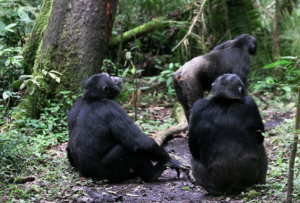 Apart from the chimpanzees, the forest also harbors primates like black and white colobus monkey, baboons, vervet monkey, red tailed monkey, L’Hoest monkey, etc. The forest is a home to over 380 bird species and some of these include; the black and white casqued hornbill. The great blue turaco, sunbirds, cuckoos, bee-eaters, starlings, not to mention but a few. The reserve also harbors approximately over 100 moths, over 270 butterflies, flowers of nature and a few reptiles. Its also a home to wildlife species that reside in savannah grassland like the lions, leopards, wild pigs, giant forest hogs, waterbucks, buffalos, duikers, elephants, etc. These animals visit this area because of the thick forest with a variety of fruits and food and also because it borders Queen Elizabeth National Park. A visit to this forest takes you through its distinct trails each of which rewards you with unique experiences. They include;
Apart from the chimpanzees, the forest also harbors primates like black and white colobus monkey, baboons, vervet monkey, red tailed monkey, L’Hoest monkey, etc. The forest is a home to over 380 bird species and some of these include; the black and white casqued hornbill. The great blue turaco, sunbirds, cuckoos, bee-eaters, starlings, not to mention but a few. The reserve also harbors approximately over 100 moths, over 270 butterflies, flowers of nature and a few reptiles. Its also a home to wildlife species that reside in savannah grassland like the lions, leopards, wild pigs, giant forest hogs, waterbucks, buffalos, duikers, elephants, etc. These animals visit this area because of the thick forest with a variety of fruits and food and also because it borders Queen Elizabeth National Park. A visit to this forest takes you through its distinct trails each of which rewards you with unique experiences. They include;
The palm trail
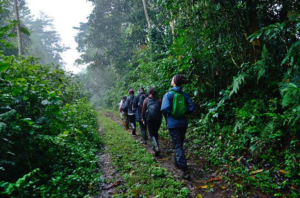 This is a 5 kilometer’s trail which takes you approximately 2 hours depending on your hiking speed. You will pass through its woodland trees and get to see unique tree species while crossing through a comparatively flat terrain in this reserve. While here, tourists are rewarded with wonderful tree species found along the path. Some of these include; the popular and interesting one being the flame tree also known for its vast. Red tulip-like flames which are believed to increase libido in women, the Raphia palm tree commonly used to making mats, ropes, baskets, etc.
This is a 5 kilometer’s trail which takes you approximately 2 hours depending on your hiking speed. You will pass through its woodland trees and get to see unique tree species while crossing through a comparatively flat terrain in this reserve. While here, tourists are rewarded with wonderful tree species found along the path. Some of these include; the popular and interesting one being the flame tree also known for its vast. Red tulip-like flames which are believed to increase libido in women, the Raphia palm tree commonly used to making mats, ropes, baskets, etc.
The valley trail
This trail takes about 4 hours and offers spectacular views of the magnificent steep slopes of the right valley. You can as well encounter various wildlife on the way.
The waterfall trail
It is 11 kilometers and takes approximately 5 hours and while here, you will have magical views over stunning Kilyantama waterfall. The trail involves tourists transversing through some hilly areas and wet terrains. It also allows tourists to see the breathtaking Kilyantama waterfall that will welcome you with its roaring sounds and serene environment.
The river trail
The river trail covers approximately 3 kilometers and takes about 1 hour depending on your hiking speed. Chimpanzees and other primates are mostly seen in this trail and tourists will also come across River Kajojo also known as “Elephant River” because elephants were known to bath from here.
What to do at Kalinzu forest reserve
Chimpanzee trekking
This is generally the main activity done in the reserve led by the guide to different trails. Chimpanzee trekking takes approximately 4 hours however, you can also come across other primates. Some of these include; the black and white colobus, baboons, vervet monkey, red tailed monkey and many more.
Chimpanzee habituation
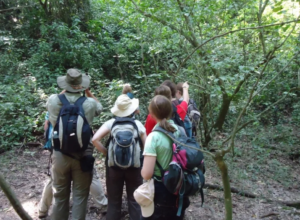
After your breakfast, have your packet lunch which you will enjoy since this activity takes the whole day. The ranger will first brief you and afterwards lead you into the forest in search for the chimpanzees. While here, you will have a rewarding view of their lifestyles as well as enjoy their daily activities. Therefore, book with us for your permits in advance to avoid inconveniences.
Bird watching
Kalinzu forest is home to over 378 bird species and its one of the best birding destinations in Uganda to all bird lovers. While doing the activity, you will have an insight to experience the different calling of different bird species. Some of the birds here include; the great blue turaco, sunbirds, black and white casqued hornbills, cuckoo, eagles, camaroptera, etc.
Wildlife viewing
Since the forest reserve is close to Queen Elizabeth National Park and the great Maramagambo forest, expect to spot some animals. Some of these include; leopards, elephants, warthogs, wild pigs giant forest hogs, waterbucks, buffalos, duikers, etc.
Camping
The forest also offers the perfect site for camping activities; in the middle of the forest, a camping site has been set up for tourists to sleep next to nature. While here, enjoy the beautiful African night while listening to amazing night animal sounds.
Guided nature walks
The guided nature walk in Kalinzu forest is an interesting activity that will offer a tourist an opportunity to explore the forest. Here, expect to see a number of different plant species since the forest is home to over 414 plant species. Also expect to spot different primates, bird species, the amazing waterfall, vegetation and plantations as well as the wildlife that come from Queen Elizabeth National Park..
Best time to visit the forest
The best time to visit this forest is in the dry season from July to August and December to February when the forest trails are not slippery however, the forest can be visited all year round.
How to get there
Kalinzu Forest Reserve is located in the western Uganda approximately 375 kilometers which is about 6 hours’ drive from Kampala. You will drive through Masaka-Mbarara-Bushenyi. Visitors can also board a bus to Butare and get a special hire to the forest.
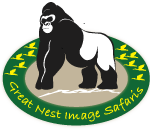
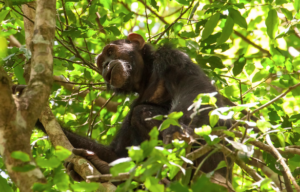 This pristine forest reserve has an amazing number of plant species whereby over 465 plant species have been recorded. Apart from the giant mahogany trees, other trees include; the spiky fagara trees, parasitic strangler figs and iron wood trees. The forest offers an extremely rich biodiversity including over 24 mammals, over 9 primates, over 280 butterfly species and birds species. It is also a natural habitat of more than 600
This pristine forest reserve has an amazing number of plant species whereby over 465 plant species have been recorded. Apart from the giant mahogany trees, other trees include; the spiky fagara trees, parasitic strangler figs and iron wood trees. The forest offers an extremely rich biodiversity including over 24 mammals, over 9 primates, over 280 butterfly species and birds species. It is also a natural habitat of more than 600 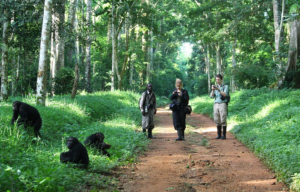 This activity is generally the number one priority in the reserve and led by an experienced ranger. The time when the fruits are shorter in supply, the
This activity is generally the number one priority in the reserve and led by an experienced ranger. The time when the fruits are shorter in supply, the 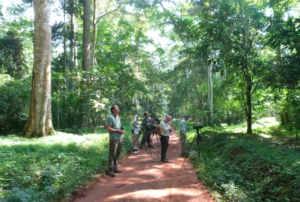 The forest is also a home to some of the rarest birds in East Africa. Its a habitat to over 360 bird species both migratory and residential. Some of the birds here include; forest robin, African emerald cuckoo, yellow and grey long bill. Yellow browed camaroptera, black headed flycatcher, chocolate backed kingfisher, white spotted flufftail, lemon bellied crombec, etc.
The forest is also a home to some of the rarest birds in East Africa. Its a habitat to over 360 bird species both migratory and residential. Some of the birds here include; forest robin, African emerald cuckoo, yellow and grey long bill. Yellow browed camaroptera, black headed flycatcher, chocolate backed kingfisher, white spotted flufftail, lemon bellied crombec, etc.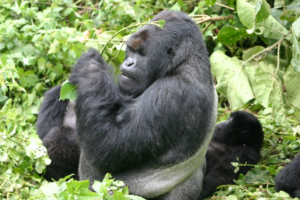 Besides, gorillas have a stocky body comprising of a broad chest, long and muscular arms plus wide feet and hands. Their arms are generally longer than their legs and live in groups called families or troops. In addition, each troop is typically composed of 2 to 30 members, 1 to 4 are male adults, and the rest are black backs. As a matter of fact, each gorilla family has a silverback as the leader who fights and defends the family.
Besides, gorillas have a stocky body comprising of a broad chest, long and muscular arms plus wide feet and hands. Their arms are generally longer than their legs and live in groups called families or troops. In addition, each troop is typically composed of 2 to 30 members, 1 to 4 are male adults, and the rest are black backs. As a matter of fact, each gorilla family has a silverback as the leader who fights and defends the family. 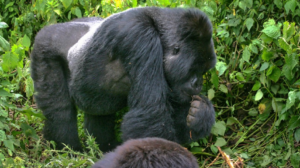 Being the leader and the biggest in the group, the silverback eats twice as much as an adult female since it performs more tasks in the group. T
Being the leader and the biggest in the group, the silverback eats twice as much as an adult female since it performs more tasks in the group. T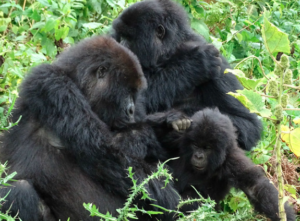 Gorillas are polygamous animals whereby all dominating
Gorillas are polygamous animals whereby all dominating  On the other hand, gorillas can mate anytime of the year and the gestation period is 8.5 months. Just like humans, and they mostly produce during night time. After delivery, a gorilla will take 4 years or more to conceive again hence they have low birth rates. Infant gorillas are born weighing 2-3 kilograms and vulnerable just like the human babies. The mother caries and has to take good care of them until 3 months when they can sit upright and can walk on their own.
On the other hand, gorillas can mate anytime of the year and the gestation period is 8.5 months. Just like humans, and they mostly produce during night time. After delivery, a gorilla will take 4 years or more to conceive again hence they have low birth rates. Infant gorillas are born weighing 2-3 kilograms and vulnerable just like the human babies. The mother caries and has to take good care of them until 3 months when they can sit upright and can walk on their own. 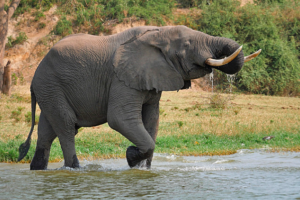 African Savanna and Forest Elephants : Did you know that an elephant is born blind, but able to walk in the first minutes? The forest elephants and the African Savanna elephants also known as the African bush elephant have a lot in common. In
African Savanna and Forest Elephants : Did you know that an elephant is born blind, but able to walk in the first minutes? The forest elephants and the African Savanna elephants also known as the African bush elephant have a lot in common. In 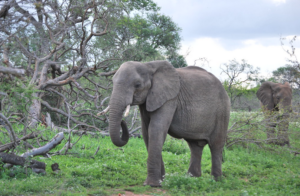 Though they both feed on trees, herbs and fruits, the
Though they both feed on trees, herbs and fruits, the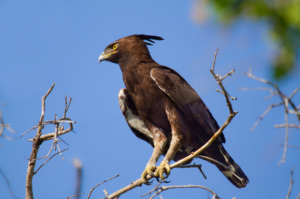 They possess an irregular long, flabby crest at the end of their crown although in females it appears short. The secondary feathers are black barred with slight grey and broad black tips. The base of the primary feathers and median underwing coverts are white forming a noticeable white patch on the upper and lower surfaces of the wing. This is always visible in flight while the tail is black and barred with little pale grey. In adults, the eyes are golden or bright yellow but at times darker in females.
They possess an irregular long, flabby crest at the end of their crown although in females it appears short. The secondary feathers are black barred with slight grey and broad black tips. The base of the primary feathers and median underwing coverts are white forming a noticeable white patch on the upper and lower surfaces of the wing. This is always visible in flight while the tail is black and barred with little pale grey. In adults, the eyes are golden or bright yellow but at times darker in females. 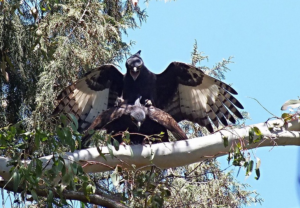 The female lays a clutch of 1-2 eggs and only the female incubates, and she is fed near by the male. However, she also leaves the nest to kill for herself sometimes. During the incubation period, the male is often near the nest and roosts in the same tree or in another close by. In the first weeks after hatching, the female remains on or near the nest while the male brings food. After three weeks, the female hunts more than the male although the female brings more prey than the male.
The female lays a clutch of 1-2 eggs and only the female incubates, and she is fed near by the male. However, she also leaves the nest to kill for herself sometimes. During the incubation period, the male is often near the nest and roosts in the same tree or in another close by. In the first weeks after hatching, the female remains on or near the nest while the male brings food. After three weeks, the female hunts more than the male although the female brings more prey than the male. 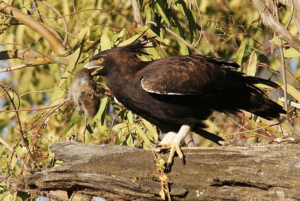 The long-crested eagle is a “sit and wait” hunter which waits on a perch, scanning the ground and swoops on prey with a gliding flight stroke. Up to 98% of the diet of the species consists of rodents like the greater cane rat. However, it also comprises of small mammals caught on the ground but also includes lizards, small snakes, etc.
The long-crested eagle is a “sit and wait” hunter which waits on a perch, scanning the ground and swoops on prey with a gliding flight stroke. Up to 98% of the diet of the species consists of rodents like the greater cane rat. However, it also comprises of small mammals caught on the ground but also includes lizards, small snakes, etc.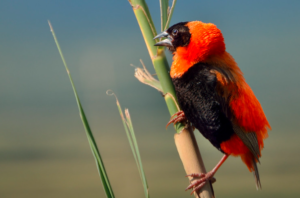 It is generally a thin, small dumpy sparrow like weaver with a length of 10-11 centimeters with a thick conical bill. The face, throat and forehead are black while the rest of the head is red. In addition, the upper parts are red apart from the brown wings and tail. The upper breast and under tail-coverts are red while the lower breast and belly are black. The female is very similar to the non-breeding male but she is smaller. Additionally, she is less densely streaked on the underparts and her bill, legs and feet are pale pinkish and her eyes are dark brown. Females and juveniles have thick, conical as well as horn-colored bills. On the other hand, males have a darker tinge to their bills and young males molt into their adult plumage at the early age of one year.
It is generally a thin, small dumpy sparrow like weaver with a length of 10-11 centimeters with a thick conical bill. The face, throat and forehead are black while the rest of the head is red. In addition, the upper parts are red apart from the brown wings and tail. The upper breast and under tail-coverts are red while the lower breast and belly are black. The female is very similar to the non-breeding male but she is smaller. Additionally, she is less densely streaked on the underparts and her bill, legs and feet are pale pinkish and her eyes are dark brown. Females and juveniles have thick, conical as well as horn-colored bills. On the other hand, males have a darker tinge to their bills and young males molt into their adult plumage at the early age of one year.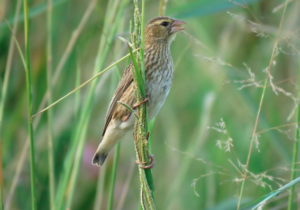 Besides, the male bird is polygamous and may own up to seven or six females or even more in his territory. The southern red bishop also performs bumble-bee-like flight with rapid wing-beats producing buzzy sounds during the breeding period. It also flies airily about over the reed bed, with fluffed out plumage. Pairs and small flocks are always close to water when breeding and mixed species colonies occur in reed beds and swampy grasslands. However, they disperse into neighboring scrubs in the non-breeding season, often in flocks. The female species has various twittering calls and a nasal contact call while the male has a buzzing song.
Besides, the male bird is polygamous and may own up to seven or six females or even more in his territory. The southern red bishop also performs bumble-bee-like flight with rapid wing-beats producing buzzy sounds during the breeding period. It also flies airily about over the reed bed, with fluffed out plumage. Pairs and small flocks are always close to water when breeding and mixed species colonies occur in reed beds and swampy grasslands. However, they disperse into neighboring scrubs in the non-breeding season, often in flocks. The female species has various twittering calls and a nasal contact call while the male has a buzzing song. 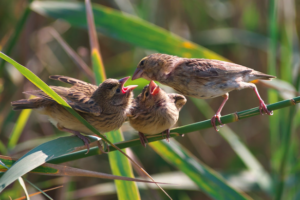 The female basically lines the interior with plant grass and seed heads, and continues during the incubation. The nest is usually placed in reeds, maize fields, sedges and other aquatic plants standing in water. Besides, the males performs aerial displays over the territory to attract females in his colony during the breeding season. The female generally lays 3 pale blue-green or turquoise eggs and incubation lasts about 12-13 days done by the female only. After hatching, she also feeds the chicks, firstly by regurgitation of seeds. Later, they fledge at the age of 11-15 days after hatching, but they are always able to leave the nest at the age of 10 days. The young male can breed at two years whilst the young female can breed at one year of age.
The female basically lines the interior with plant grass and seed heads, and continues during the incubation. The nest is usually placed in reeds, maize fields, sedges and other aquatic plants standing in water. Besides, the males performs aerial displays over the territory to attract females in his colony during the breeding season. The female generally lays 3 pale blue-green or turquoise eggs and incubation lasts about 12-13 days done by the female only. After hatching, she also feeds the chicks, firstly by regurgitation of seeds. Later, they fledge at the age of 11-15 days after hatching, but they are always able to leave the nest at the age of 10 days. The young male can breed at two years whilst the young female can breed at one year of age. 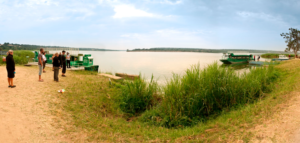 The lake is located in Kasese district, in the western region of Uganda and shared by Uganda about 29% of its surface area and the Democratic Republic of Congo 71% of the surface area. The Lake generally covers a surface area of about 2325 square kilometers lying at an elevation of 920 meters and it’s not so deep. The main inflows of the lake include; River Ntungwe, River Ishasha, River Rutshuru, River Nyamugasani, River Rwindi and River Lubilia.
The lake is located in Kasese district, in the western region of Uganda and shared by Uganda about 29% of its surface area and the Democratic Republic of Congo 71% of the surface area. The Lake generally covers a surface area of about 2325 square kilometers lying at an elevation of 920 meters and it’s not so deep. The main inflows of the lake include; River Ntungwe, River Ishasha, River Rutshuru, River Nyamugasani, River Rwindi and River Lubilia.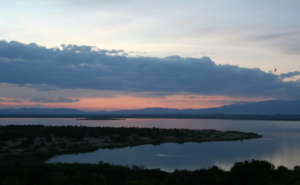 The main inlet to Lake Edward is river Semliki and
The main inlet to Lake Edward is river Semliki and 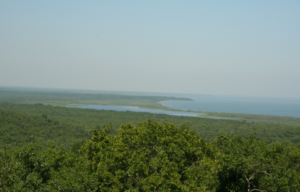 Like Lake George, Lake Edward is designated as a Ramsar site due to the importance of its wetland habitat. The Lake is inhabited by many fishing species. These include; the Nile tilapia, Oreo chromil, Leocosticus, Haplochromine, Haplochromis, Blue-spotted tilapia, etc. Fishing is an important activity and it provides an income for the local residents. Here, the Vitshumbi is the largest of the local fishing markets.
Like Lake George, Lake Edward is designated as a Ramsar site due to the importance of its wetland habitat. The Lake is inhabited by many fishing species. These include; the Nile tilapia, Oreo chromil, Leocosticus, Haplochromine, Haplochromis, Blue-spotted tilapia, etc. Fishing is an important activity and it provides an income for the local residents. Here, the Vitshumbi is the largest of the local fishing markets.  Besides, Lake George has got some islands recorded such as Kankuranga, Irangara as well as Akika. Its inflows include; Dura, Mpanga, Nsonge, Rumi, Katonga and Mubuku from Rwenzori. The lake possesses its major catchment area within the Rwenzori ranges and the northeastern agricultural area.
Besides, Lake George has got some islands recorded such as Kankuranga, Irangara as well as Akika. Its inflows include; Dura, Mpanga, Nsonge, Rumi, Katonga and Mubuku from Rwenzori. The lake possesses its major catchment area within the Rwenzori ranges and the northeastern agricultural area. 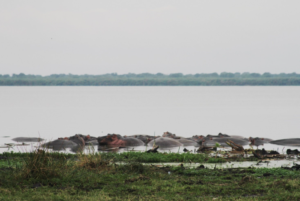 Later, he renamed it “George” on his return in 1888 after realizing they were two independent lakes.
Later, he renamed it “George” on his return in 1888 after realizing they were two independent lakes.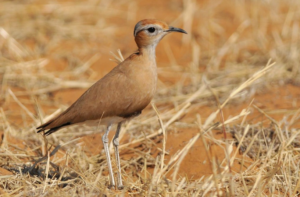 The Burchell’s courser bill is generally long, arched down and of a dark color like eyes. It possesses a blue-grey hind crown, a horizontal black band demarcating a white down belly and an overall pale rufous color. The face feathers are white supercilia above black eye lines, all concluding at the back of the neck forming a double V. Additionally, its secondary feathers are mostly white with a black underwing and brown to grey coverts. Females and males look analogous whilst juveniles miss the rufous color, the facial stripes and the grey hind crown of the adults. This bird with its camouflage appearance blending within the landscape making it challenging to spot.
The Burchell’s courser bill is generally long, arched down and of a dark color like eyes. It possesses a blue-grey hind crown, a horizontal black band demarcating a white down belly and an overall pale rufous color. The face feathers are white supercilia above black eye lines, all concluding at the back of the neck forming a double V. Additionally, its secondary feathers are mostly white with a black underwing and brown to grey coverts. Females and males look analogous whilst juveniles miss the rufous color, the facial stripes and the grey hind crown of the adults. This bird with its camouflage appearance blending within the landscape making it challenging to spot.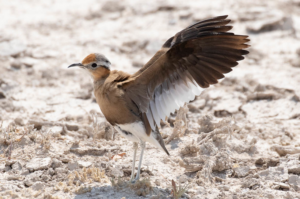 Referring to their names, coursers are great runners as their name suggests hence they need open grounds. Most birds prefer running to flying in case they are disturbed however they fly extremely well. Their plumage is normally highly cryptic thus providing excellent camouflage which they rely on for concealment. Coursers are typically true migratory birds although some may have more or less seasonal movements. Besides, they tend to be rather shy as a rule, seldom allowing a close approach, then running rapidly away before taking flight if pressed. They are active both day and night, becoming partly nocturnal during hot weathers especially on moon lit nights.
Referring to their names, coursers are great runners as their name suggests hence they need open grounds. Most birds prefer running to flying in case they are disturbed however they fly extremely well. Their plumage is normally highly cryptic thus providing excellent camouflage which they rely on for concealment. Coursers are typically true migratory birds although some may have more or less seasonal movements. Besides, they tend to be rather shy as a rule, seldom allowing a close approach, then running rapidly away before taking flight if pressed. They are active both day and night, becoming partly nocturnal during hot weathers especially on moon lit nights.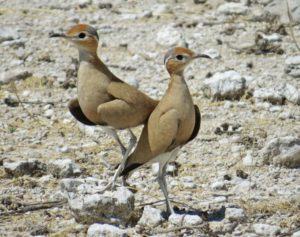 The birds are monogamous and occur in small flocks but usually are solitary nesters. They nest on the ground without any nest, or even in a shallow scrape in the soil. It lays a clutch of two eggs directly on the ground sometimes surrounded by stools of antelopes, small rocks or dried up organic matter. The eggs consists of an oval shape with black looks from a far distance, but they are actually of a buff color with many dark markings. Both parents participate in the incubation period however, uncertainties are expected during the hatching and fledging times. Even though chicks are considered precocial, they lack the heat-loss mechanisms possessed by the adults to survive the hot climate and thus shade to avoid overheating.
The birds are monogamous and occur in small flocks but usually are solitary nesters. They nest on the ground without any nest, or even in a shallow scrape in the soil. It lays a clutch of two eggs directly on the ground sometimes surrounded by stools of antelopes, small rocks or dried up organic matter. The eggs consists of an oval shape with black looks from a far distance, but they are actually of a buff color with many dark markings. Both parents participate in the incubation period however, uncertainties are expected during the hatching and fledging times. Even though chicks are considered precocial, they lack the heat-loss mechanisms possessed by the adults to survive the hot climate and thus shade to avoid overheating. 




